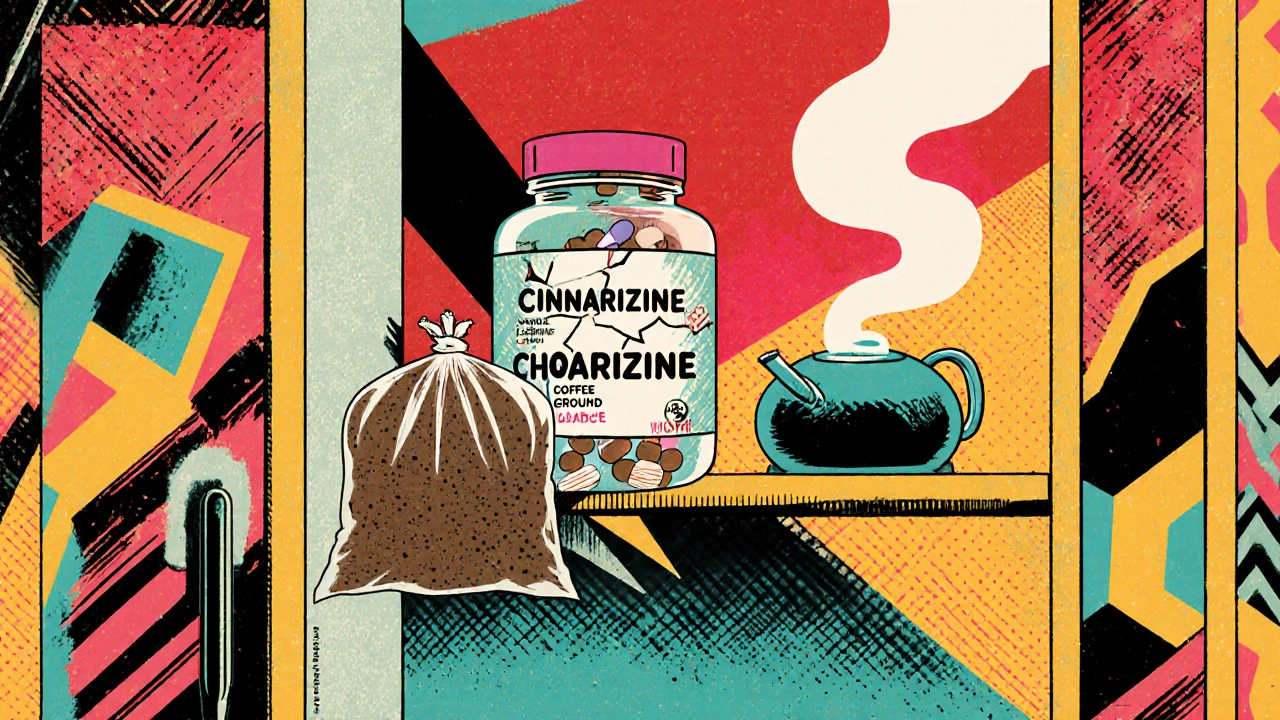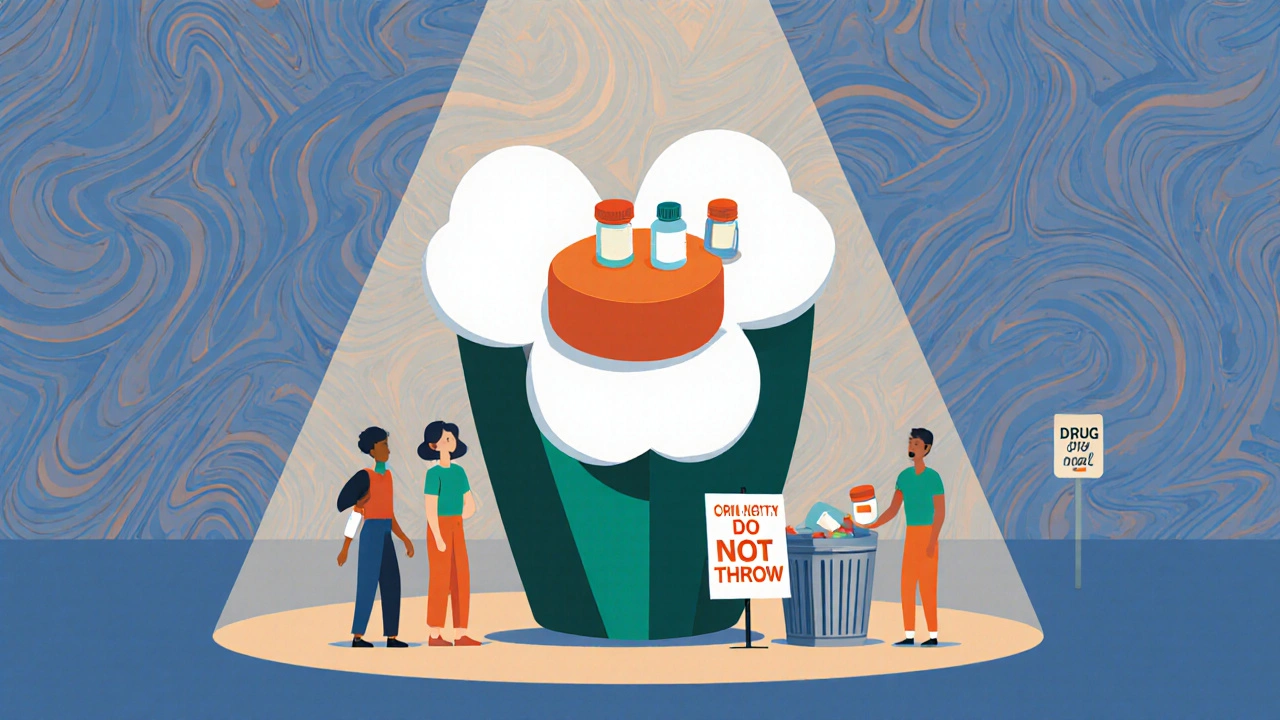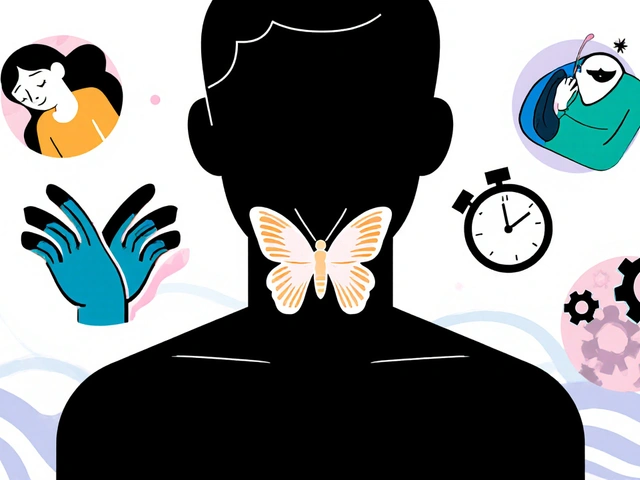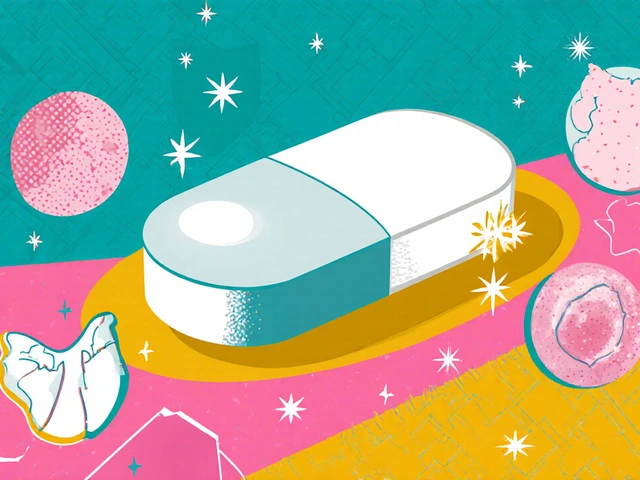Keeping cinnarizine out of reach of children and pets isn’t just a good idea-it’s a safety rule that could prevent an emergency. This medication, often prescribed for motion sickness and vertigo, can cause serious side effects if taken by someone it wasn’t meant for. Even a single extra pill can lead to drowsiness, confusion, or worse. So how do you really store it right? And what do you do with leftover pills after your treatment ends? Let’s cut through the confusion.
Where to Store Cinnarizine
Cinnarizine should be kept in a cool, dry place, away from moisture and heat. That means no bathroom cabinets. The steam from showers and sinks can break down the medication over time, making it less effective or even unsafe. A bedroom drawer, a kitchen cabinet away from the stove, or a high shelf in a closet are better choices.
Always keep it in its original bottle. The label has your name, the dosage, and the expiration date. If you transfer it to a pill organizer, you lose that critical safety info. If you use a daily pill box, keep the original bottle nearby as a backup. Never store cinnarizine in a purse, glove compartment, or anywhere exposed to temperature swings. In hot weather, the pills can melt or degrade.
Lock it up if you have kids or visitors who might be tempted to try it. Cinnarizine isn’t addictive like opioids, but it can still cause dizziness or hallucinations in someone who doesn’t need it. A simple lockbox or medicine cabinet with a childproof latch is enough. Many pharmacies sell affordable lockboxes designed for this exact purpose.
How Long Does Cinnarizine Last?
Check the expiration date on the bottle. Cinnarizine usually lasts two to three years from the manufacturing date, but once opened, it’s best used within one year. If the pills look cracked, discolored, or smell odd, toss them-even if they’re technically still within the expiration window.
Don’t rely on memory. Write the opening date on the bottle with a marker. If you haven’t used the bottle in six months, ask your pharmacist if it’s still good. Some medications lose potency faster than others, and cinnarizine is one of them.
What to Do With Expired or Unused Cinnarizine
Never flush cinnarizine down the toilet or throw it in the trash without taking steps to make it unusable. Flushing can pollute water systems. Throwing it in the garbage leaves it vulnerable to accidental ingestion or misuse.
The safest option is a drug take-back program. Many pharmacies, hospitals, and police stations offer drop-off bins for expired or unwanted medications. Call your local pharmacy or check your city’s public health website. In 2025, over 80% of U.S. counties and most major Canadian cities have at least one permanent collection site.
If no take-back option is available, mix the pills with something unappetizing-used coffee grounds, cat litter, or dirt. Put the mixture in a sealed plastic bag, then into a closed trash can. This makes it unappealing and unrecognizable. Don’t crush the pills unless instructed by a pharmacist-some formulations are designed to release slowly, and crushing can change how they behave.
Remove or black out your personal information on the bottle before recycling it. Use a permanent marker or peel off the label. This protects your privacy.

What Not to Do
Don’t give leftover cinnarizine to someone else-even if they have similar symptoms. What works for you might cause dangerous side effects in them. People with liver problems, Parkinson’s disease, or glaucoma can have severe reactions.
Don’t store it with other medications in one big container. Mixing pills increases the risk of accidental overdose. Cinnarizine can interact with antidepressants, antihistamines, and alcohol. Keeping them separate reduces confusion.
Don’t ignore expired pills. Just because they don’t look bad doesn’t mean they’re safe. Medications can break down into harmful substances over time. A 2023 FDA study found that 12% of expired antihistamines (including cinnarizine) had degraded into compounds that could irritate the stomach lining.
Special Cases
If you’re caring for an elderly relative, keep their cinnarizine in a clearly labeled container with the dosage and time of day written in large print. Use a pill dispenser with alarms if needed. Seniors are more sensitive to cinnarizine’s sedative effects, and confusion from improper dosing can lead to falls.
If you’re traveling, carry cinnarizine in your carry-on luggage. Checked bags can get lost or exposed to extreme temperatures. Bring the original bottle with the prescription label-it may be required at security or customs.
For pregnant or breastfeeding women, always consult a doctor before using or disposing of cinnarizine. While it’s sometimes used for severe vertigo in pregnancy, it can pass into breast milk. Never stop or start taking it without medical advice.

What Happens If Someone Accidentally Takes It?
If a child, pet, or adult takes cinnarizine by mistake, act fast. Call poison control immediately. In the U.S., that’s 1-800-222-1222. In Canada, dial 1-844-727-7468. Have the bottle handy when you call-details like dosage and time of ingestion matter.
Symptoms of overdose include extreme drowsiness, blurred vision, tremors, difficulty speaking, or slow breathing. If someone is unconscious or not breathing, call 911 right away. Don’t wait for symptoms to get worse. Cinnarizine can suppress the central nervous system quickly.
How to Prevent Accidents
Set a reminder on your phone to check your medicine cabinet every three months. Look for expired or unused pills. Make disposal a routine, like changing smoke detector batteries.
Talk to your family about medication safety. Kids don’t always understand that pills aren’t candy. Even teens might experiment if they think it’s harmless. Explain that cinnarizine isn’t a sleeping pill-it’s a prescription drug with real risks.
Ask your pharmacist for a free medication disposal kit. Some pharmacies now offer small pouches with absorbent powder that deactivate pills when mixed in. These are especially useful for people living in rural areas without take-back sites.
When you finish your course of cinnarizine, don’t just tuck the bottle away. Dispose of it properly. It’s not waste-it’s a potential hazard. Safe storage and disposal aren’t optional. They’re part of responsible medication use.
Can I flush cinnarizine down the toilet?
No, you should never flush cinnarizine or any medication down the toilet unless the label specifically says to. Flushing can contaminate water supplies and harm aquatic life. Even if your toilet seems like the easiest option, it’s not the safest one. Use a drug take-back program or mix the pills with coffee grounds and throw them in the trash instead.
How long can I keep cinnarizine after opening the bottle?
Most manufacturers recommend using cinnarizine within one year after opening, even if the expiration date is later. Exposure to air, humidity, and light can reduce its effectiveness. If the pills look different-discolored, sticky, or cracked-discard them immediately, regardless of the date.
Is it safe to store cinnarizine in the refrigerator?
No, unless your pharmacist or the label says to. Cinnarizine is stable at room temperature. Refrigeration can cause moisture buildup inside the bottle, which may degrade the pills. Keep it in a dry, cool place like a bedroom drawer or closet shelf instead.
What should I do if I find old cinnarizine in my medicine cabinet?
Check the expiration date and the condition of the pills. If they’re expired or look damaged, dispose of them safely. Mix them with used coffee grounds or cat litter, seal them in a plastic bag, and throw them in the trash. Remove your personal info from the bottle first. If you’re unsure, call your pharmacist-they can help you decide.
Can I give my leftover cinnarizine to a friend with motion sickness?
No. Cinnarizine is prescribed based on individual health history, weight, and other medications. What’s safe for you could cause serious side effects in someone else, especially if they have liver issues, Parkinson’s, or are taking other sedatives. Never share prescription medication, even if it seems harmless.


